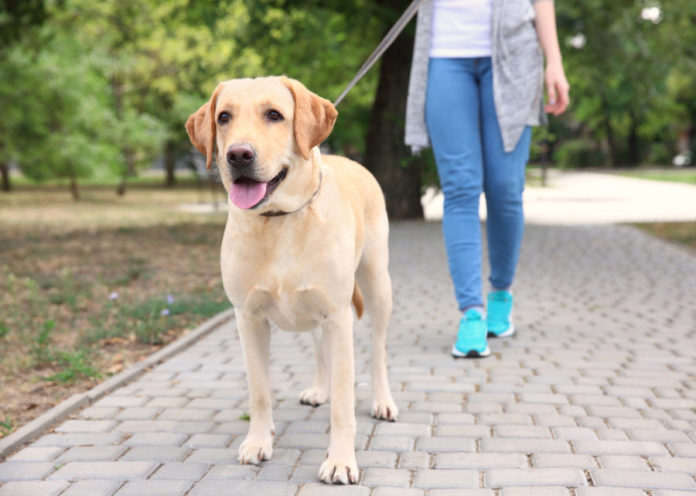Daily walks and exercise help more rescue and shelter dogs find forever homes by giving them physical and mental stimulation and teaching them valuable skills such as socialization and leash etiquette.
Every pooch needs physical exercise, and shelter dogs are no exception. In fact, structured walking programs at shelters and rescues help make dogs more adoptable by giving them exercise and stimulation, teaching them about leash etiquette, and providing them with opportunities to bond with humans. Many rescues and shelters in both the US and Canada, such as those featured in this article, are implementing organized walking and exercise programs to help improve their dogs’ well-being, and to make them more appealing to potential adopters.
Shelters and rescues with walking and exercise programs
Grosse Pointe Animal Adoption Society
Before 2012, rescued dogs at Grosse Pointe Animal Adoption Society in Grosse Point, Michigan, rarely got any fresh air except when let out to do their business. At the time, this adoption facility was no different than most other rescues and shelters. With overflowing populations and minimal staffing, it was all workers could do to provide the four-legged inhabitants with a clean but somewhat cramped living area. The dogs were frustrated, yearning for some time outdoors, and it showed.
Since then, Grosse Pointe has implemented a structured dog-walking program that involves three shifts of caring, outgoing volunteers. These volunteers take the dogs on 20-minute walks per shift, so the 20 to 25 canines residing at the facility each receive plenty of exercise and opportunities to interact with different people. The dogs also get a chance to strut, sniff and romp in a variety of environments, giving them a very welcome hiatus from the wired confines of the shelter.
“We have found that walking the dogs outdoors provides ‘normalcy’ for them during their shelter environment stay,” says Corrinne Martin, director of the foundation. “They are healthier and happier and enjoy interacting with the various volunteers who walk them.” Staff and volunteers swear they see their dogs smile as the crate doors opens and leash clasps snap.
Rancho Coastal Humane Society
Located in Encinitas, California, the Rancho Coastal Humane Society sits on five acres of open land, providing a lot of outdoor scope for resident dogs.
“We have an exercise yard with runs that go across the property,” said John Van Zante, public relations director. “There’s a trail that goes along a wetland area, and we also have our longer Waggin’ Walks, which run two to three miles.”
Staff and volunteers spend one-on-one time with each dog. Besides outdoor walks and exercise, the dogs are also taken to shopping centers to get them socialized with people.
John says the program pays off when would-be adopters visit. “When people come in, they say: ‘I can’t believe how social the dogs are, how friendly they are.’ It’s because they get exercise, they experience one-on-one contact with people, and they enjoy interaction with other dogs. Our volunteers make sure each dog is socialized.”
“When people come in, they say: ‘I can’t believe how social the dogs are, how friendly they are.’”
Etobicoke Humane Society
Another shelter that has put a walking program in place for its dogs is the Etobicoke Humane Society in Ontario.
“We have three shifts for volunteers: morning, afternoon and evening,” says Amy Ma, managing director of operations. “We take our dogs out on walks of at least 30 minutes per volunteer shift. So in total, the dogs get at least 90 minutes outside every day. Sometimes, we have dogs that need longer walks, and our adoption coordinators will take them out to off-leash dog parks or large yards where they can run around for hours.”
 These programs pay off
These programs pay off
Shelters and rescues strive to do whatever is necessary to increase the chances of finding permanent homes for their four-legged residents. The overwhelming consensus is that walking programs are key because they provide exercise, stimulation, leash etiquette, socialization, and opportunities for bonding with people and other dogs. This in turn leads to friendlier, happier and more balanced dogs with a much better chance of finding their forever homes.
Regular walking gives dogs physical, mental and social benefits
“Getting shelter dogs outside gives them an energy outlet as well as mental stimulation, and keeps their muscles in shape,” said Julie Speyer, owner and lead behavior specialist for the Canine Foundation in Barrie, Ontario. The foundation works with organizations such as animal rescues, modifying canine behavior to suit specific needs.
Julie adds that walking serves another very valuable service. “When dogs are kenneled for prolonged periods without any stimulation and socialization, they go ‘kennel crazy’. What we call ‘environmental enrichment walks’ allow dogs to get outside to sniff and see the world. This helps create calmer and more relaxed behaviors within the shelter environment, and stimuli such as people or cars are no longer novel.
“If a dog is kept in a kennel for long periods, the sight of people or cars can be very scary to him,” Julie continues. “By taking him for walks, these stimuli become familiar. We are also able to identify dogs that are having struggles with these type of stimuli and can start working on those issues so they won’t be a problem when they go into their new homes.”
Needless to say, a dog that acts in a calm, friendly manner when potential adopters visit the shelter is more likely to be adopted than one that’s fearful, high-strung or wary of people. Regular walks also help train the dog to learn good leash etiquette, so he’ll be a well-behaved walking partner for his new family.

